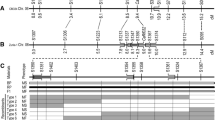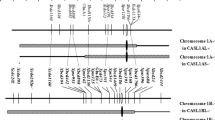Abstract
A new large set of reciprocal recombinant inbred lines (RILs) was created between the Arabidopsis accessions Col-0 and C24 for quantitative trait mapping approaches, consisting of 209 Col-0 × C24 and 214 C24 × Col-0 F7 RI lines. Genotyping was performed using 110 evenly distributed framework single nucleotide polymorphism markers, yielding a genetic map of 425.70 cM, with an average interval of 3.87 cM. Segregation distortion (SD) was observed in several genomic regions during the construction of the genetic map. Linkage disequilibrium analysis revealed an association between a distorted region at the bottom of chromosome V and a non-distorted region on chromosome IV. A detailed analysis of the RILs for these two regions showed that an SD occurred when homozygous Col-0 alleles on chromosome IV coincided with homozygous C24 alleles at the bottom of chromosome V. Using nearly isogenic lines segregating for the distorted region we confirmed that this genotypic composition leads to reduced fertility and fitness.






Similar content being viewed by others
References
Alonso-Blanco C, Peeters AJ, Koornneef M, Lister C, Dean C, van den Bosch N, Pot J, Kuiper MT (1998) Development of an AFLP based linkage map of Ler, Col and Cvi Arabidopsis thaliana ecotypes and construction of a Ler/Cvi recombinant inbred line population. Plant J 14:259–271
Bechsgaard J, Bataillon T, Schierup MH (2004) Uneven segregation of sporophytic self-incompatibility alleles in Arabidopsis lyrata. J Evol Biol 17:554–561
Benito C, Figueras AM, Zaragoza C, Gallego FJ, de la Pena A (1993) Rapid identification of Triticeae genotypes from single seeds using the polymerase chain reaction. Plant Mol Biol 21:181–183
Boivin K, Acarkan A, Mbulu RS, Clarenz O, Schmidt R (2004) The Arabidopsis genome sequence as a tool for genome analysis in Brassicaceae. A comparison of the Arabidopsis and Capsella rubella genomes. Plant Physiol 135:735–744
Borevitz J, Maloof J, Lutes J, Tsegaye D, Redfern JL, Trainer GT, Werner JD, Asami T, Berry CC, Weigel D, Chory J (2002) Quantitative trait loci controlling light and hormone response in two accessions of Arabidopsis thaliana. Genetics 160:683–696
Darvasi A (1998) Experimental strategies for the genetic dissection of complex traits in animal models. Nat Genet 18:19–24
El-Lithy ME, Bentsink L, Hanhart CJ, Ruys GJ, Rovito D, Broekhof JLM, van der Poel HJA, van Eijk MJT, Vreugdenhil D, Koornneef M (2006) New Arabidopsis recombinant inbred line populations genotyped using SNPWave and their use for mapping flowering-time quantitative trait loci. Genetics 172:1867–1876
Haldane JBS (1919) The combination of linkage values, and the calculation of distances between the loci of linked factors. J Genet 1919:299–309
Hormaza JI, Herrero M (1992) Pollen selection. Theor Appl Genet 83:663–672
Koornneef M, Alonso-Blanco C, Peeters AJM (1997) Genetic approaches in plant physiology. New Phytol 137:1–8
Koornneef M, Alonso-Blanco C, Vreugdenhil D (2004) Naturally occurring genetic variation in Arabidopsis thaliana. Ann Rev Plant Biol 55:141–172
Kuittinen H, de Haan AA, Vogl C, Oikarinen S, Leppala J, Koch M, Mitchell-Olds T, Langley C, Savolainen O (2004) Comparing the linkage maps of the close relatives Arabidopsis lyrata and Arabidopsis thaliana. Genetics 168:1575–1584
Lambrides CJ, Godwin ID, Lawn RJ, Imrie BC (2004) Segregation distortion for seed testa color in mungbean (Vigna radiata L. Wilcek). J Hered 95:532–535
Li Z, Pinson SRM, Paterson AH, Park WD, Stansel JW (1997) Genetics of hybrid sterility and hybrid breakdown in an intersubspecific rice (Oryza sativa L.) population. Genetics 145:1139–1148
Lin X, Kaul S, Rounsley S, Shea TP, Benito MI, Town CD, Fujii CY, Mason T, Bowman CL, Barnstead M et al (1999) Sequence and analysis of chromosome 2 of the plant Arabidopsis thaliana. Nature 402:761–768
Lister C, Dean C (1993) Recombinant inbred lines for mapping RFLP and phenotypic markers in Arabidopsis thaliana. Plant J 4:745–750
Liu K, Muse SV (2005) PowerMarker: an integrated analysis environment for genetic marker analysis. Bioinformatics 21:2128–2129
Lord EM, Russell SD (2002) Mechanisms of pollination and fertilization in plants. Annu Rev Cell Dev Biol 18:81–105
Loudet O, Chaillou S, Camilleri C, Bouchez D, Daniel-Vedele F (2002) Bay-0 × Shahdara recombinant inbred line population: a powerful tool for the genetic dissection of complex traits in Arabidopsis. TAG 104:1173–1184
Lu H, Romero-Severson J, Bernardo R (2002) Chromosomal regions associated with segregation distortion in maize. Theor Appl Genet 105:622–628
Lyttle TW (1991) Segregation distorters. Annu Rev Genet 25:511–557
Lyttle TW (1993) Cheaters sometimes prosper distortion of Mendelian segregation by meiotic drive. Trends Genet 9:205–210
Mayer K, Schuller C, Wambutt R, Murphy G, Volckaert G, Pohl T, Dusterhoft A, Stiekema W, Entian KD, Terryn N et al (1999) Sequence and analysis of chromosome 4 of the plant Arabidopsis thaliana. Nature 402:769–777
Peleman JD, Wye C, Zethof J, Sørensen AP, Verbakel H, van Oeveren J, Gerats T, van der Voort JR (2005) Quantitative trait locus (QTL) isogenic recombinant analysis: a method for high-resolution mapping of QTL within a single population. Genetics 171:1341–1352
Sano Y (1990) The genic nature of gamete eliminator in rice. Genetics 125:183–191
Schmid KJ, Törjék O, Meyer R, Schmuths H, Hoffmann MH, Altmann T (2006) Evidence for pleistocene refugia and postglacial expansion of Arabiodpsis thaliana from genome-wide SNP markers. TAG 112:1104–1114
Schoof H, Zaccaria P, Gundlach H, Lemcke K, Rudd S, Kolesov G, Arnold R, Mewes HW, Mayer KF (2002) MIPS Arabidopsis thaliana Database (MAtDB): an integrated biological knowledge resource based on the first complete plant genome. Nucleic Acids Res 30:91–93
Silver LM (1993) The peculiar journey of a selfish chromosome: mouse t haplotypes and meiotic drive. Trends Genet 9:250–254
Sokal RR, Rohlf FJ (1995) Biometry: the principles and practice of statistics in biological research. W. H. Freeman and Company, New York
Taylor DR, Ingvarsson PK (2003) Common features of segregation distortion in plants and animals. Genetica 117:27–35
Törjék O, Bucherna N, Kiss E, Homoki H, Finta-Korpelova Z, Bócsa I, Nagy I, Heszky LE (2002) Novel male-specific molecular markers (MADC5, MADC6) in hemp. Euphytica 127:209–218
Törjék O, Berger D, Meyer RC, Müssig C, Schmid KJ, Sörensen TR, Weisshaar B, Mitchell-Olds T, Altmann T (2003) Establishment of a high-efficiency SNP-based framework marker set for Arabidopsis. Plant J 36:122–140
Van Ooijen JW, Voorrips RE (2001) JoinMap® version 3.0: software for the calculation of genetic linkage maps. Plant Research International, Wageningen
Wang C, Zhu C, Zhai H, Wan J (2005) Mapping segregation distortion loci and quantitative trait loci for spikelet sterility in rice (Oryza sativa L.). Genet Res 86:97–106
Werner JD, Borevitz J, Warthmann N, Trainer GT, Ecker JR et al (2005) Quantitative trait locus mapping and DNA array hybridization identify an FLM deletion as a cause for natural flowering-time variation. Proc Natl Acad Sci USA 102:2460–2465
Xu Y, Zhu L, Xiao J, Huang N, McCouch SR (1997) Chromosomal regions associated with segregation distortion of molecular markers in F2, backcross, doubled haploid and recombinant inbred populations in rice (Oryza sativa L.). Mol Gen Genet 253:535–545
Yin TM, DiFazio SP, Gunter LE, Riemenschneider D, Tuskan GA (2004) Large-scale heterospecific segregation distortion in Populus revealed by dense genetic map. Theor Appl Genet 109:451–463
Zamir D (2001) Improving plant breeding with exotic genetic libraries. Nat Rev Genet 2:983–989
Acknowledgments
We thank Maik Zehnsdorf, Melanie Lück and Monique Zeh for excellent technical assistance, and Katrin Seehaus and Steffi Zimmermann for plant care. This work was supported by a grants of the Bundesministerium für Bildung und Forschung (BMBF) (#0312275A, #0313061 as part of the GABI program) to T.A., grants of the Deutsche Forschungsgesellschaft (DFG) to T.A. and R.C.M. (AL 387/6-1, 6-2) and to B.K. (ME 931/4-1, 4-2), a grant of the European Community to T.A. (QLG2-CT-2001-01097), and by the Max-Planck-Society.
Author information
Authors and Affiliations
Corresponding author
Additional information
Communicated by C. Quiros.
Ottó Törjék and Hanna Witucka-Wall contributed equally to this work.
Rights and permissions
About this article
Cite this article
Törjék, O., Witucka-Wall, H., Meyer, R.C. et al. Segregation distortion in Arabidopsis C24/Col-0 and Col-0/C24 recombinant inbred line populations is due to reduced fertility caused by epistatic interaction of two loci. Theor Appl Genet 113, 1551–1561 (2006). https://doi.org/10.1007/s00122-006-0402-3
Received:
Accepted:
Published:
Issue Date:
DOI: https://doi.org/10.1007/s00122-006-0402-3




